The X-Files owes a conscious debt to Twin Peaks, in quite a few ways. David Lynch’s landmark television series perfectly blended the mundane with the surreal, creating a world that managed to be both incredibly familiar and hauntingly ethereal. One of the hallmarks of Lynch’s approach to Twin Peaks – and of his work in general including, most obviously, Blue Velvet and Dumbland – was the sense that there was something quite horrid and rotten lurking beneath the flowerbeds and picket fences of those lovely suburban houses.
Eve is the show’s first real exploration of suburbia, hitting on all manner of rich Cold War anxieties and fears lurking just behind those neatly-trimmed hedges.
It’s worth offering a quick history of suburbia. Like many of the fears explored in this first season of The X-Files, suburbia really developed in the wake of the Second World War, and so is linked to the emergence of America as a global power and associated with various Cold War fears. Rooted in a postwar housing shortage, suburbia developed rather quickly:
Then came World War Two, and the subsequent housing shortage. The Federal Housing Administration had already begun insuring long-term mortgage loans made by private lenders, and the GI Bill provided low-interest, zero-down-payment loans to millions of veterans. The widespread adoption of the car by the middle class untethered developers from the constraints of public transportation and they began to push further out geographically. Meanwhile, single-use zoning laws that carved land into buckets for residential, commercial and industrial use instead of having a single downtown core altered the look, feel and overall DNA of our modern suburbs. From then on, residential communities were built around a different model entirely, one that abandoned the urban grid pattern in favor of a circular, asymmetrical system made of curving subdivisions, looping streets and cul-de-sacs.
There’s something quite unnerving about suburbia, where the houses all seem to be roughly the same, the lawns are all carefully maintained, the streets seem to continue endlessly – either looping back on themselves or coming to dead ends.
Suburbia became the source of a strange grassroots political movement during the Cold War, one anchored in the same sort of mistrust and paranoia that we associate with The X-Files, arguably making it the perfect setting for a horror story like this. As Vanessa Barker explains in The Politics of Imprisonment, California’s suburban neighbourhoods became an enclave of the political right:
In the postwar era, midwestern and other white middle-class professionals flocked to southern California, lured by the prosperous defense industry, cheap land, and federally subsidised suburban housing. Although the middle classes flourished, the reality of cold war politics infused their daily lives and heightened their atomised suburban living – conditions that brewed feelings of insecurity and paranoia.
These feelings of insecurity and paranoia are a vital ingredient for The X-Files. As Lisa McGirr explains in Suburban Warriors: The Origins of the New American Right, suburbia became the home of a certain sort of entrenched political mentality, a bastion of a particular school of political thought.
You can see a discomfort with suburbia in a lot of American literature and pop culture in the second half of the twentieth century, as writers and commentators dared to imagine the seedy secrets festering beneath those perfectly maintained lawns. The Stepford Wives is perhaps the most famous example, with Blue Velvet also well-known, but there’s a pretty impressive body of work concerned with exposing the darkness lurking behind those picket fences – ranging from The Twilight Zone‘s The Monsters are Due on Maple Street through to Shirley Jackson’s Just an Ordinary Day.
Those fond of exaggerated rhetoric might describe suburbia as a battleground between two sets of American ideals. Certainly, suburbia is still something of a heated topic. An inflammatory Wall Street Journal headline from earlier this year asserted that California was declaring “a war on suburbia.” The X-Files exists in the wake of the Cold War, and it’s very much an introspective exploration of Americana. As such, turning the lens on suburban living makes a great deal of sense.
What do we do when there are no more wars to fight, no more enemies to conquer? We probably reflect, and contemplate, and realise that perhaps things are not as happy and as tranquil as we would have thought. Without any need to stare outwards, we turn our focus inwards. We notice the shapes lurking in the shadows, the eyes staring out at us from under the bed. Perhaps, as Fallen Angel suggests, we find new enemies to focus on. Or perhaps we deal with the fallout from half-a-century of perpetual ideological conflict.
It’s no coincidence that – like the suburbs – the “Eve project” is rooted in postwar Americana. We’re less than half-way through the first season, and already The X-Files has revealed itself to be fascinated in America’s moral authority in the wake of the Second World War. Oppenheimer has been evoked quite regularly – by name in Ghost in the Machine and by a supporting character’s name in Fallen Angel.
Here, Deep Throat explains that the Eves are not the result of some last-ditch attempt to win the Second World War. Instead, they are a curiosity the United States created in its aftermath. It’s the result of the government “fooling around with eugenics.” Like the black-uniform-wearing jackboot “fascist” thugs in Fallen Angel, the implication is uncomfortable. Isn’t the conventional heroic narrative that the Second World War fought on a moral imperative to prevent such things from occurring?
Eve never mentions the Nazis directly, but it alludes pretty heavily. The X-Files would tackle the post-war relocation of prominent Axis scientists and research in its third season, but it’s hard to watch Eve without thinking of Operation Paperclip, a piece of history that is often overlooked when discussing the triumph of democracy and justice during the Second World War. Was German research used in this top secret eugenics experiment? Were some of the scientists working to create these “super soldiers” war criminals who had eluded justice?
Eve never broaches the topic directly, perhaps fearing that it might open a whole can of worms. It’s also possible that Carter and the writers thought that it might be best to explore those shady postwar deals head-on in a later episode, rather than grafting the issue on to an already crowded first-season story. Still, as we witness the sociopathic monsters produced by reckless genetic engineering, it’s hard to see them as anything but the embodiment of sins past.
Which brings us to the episode’s suburban setting. These kids aren’t kept under lock-and-key or held for study. They are wandering around in the world. They could be anywhere. And they anyone. Creepy kids are a wonderful horror visual – one that the genre keeps returning to, time after time. Part of that appeal is rooted in the shock appeal of murderous children – psychopathic pint-sized killing machines are so weird as to be inherently scary. However, there’s also something deeper at play.
Children are a great way to scare an audience. Whether it’s putting them in peril or making them the source of peril, children make audiences feel uncomfortable. There’s something very unsettling about the notion that our children might be monsters – that the next generation might suddenly decide that we’re obsolete. There’s also something macabre about seeing the hope that children are supposed to represent – some vague form of immortality – warped and twisted into something grotesque.
After all, seeing children become murderous sociopaths reflects pretty damningly on us. Of course, scientific studies and empirical evidence suggests that some traits are genetic or inherent (indeed, in Eve, it’s explicitly stated that their problems are genetic), but there’s still some vague unsettling sense of failure when we watch children turn into monsters. It’s a form of reproductive horror – the sense that we (whether as individuals or as a culture) have created something truly grotesque and horrifying.
In the case of the two identical girls here, that discomfort is rooted in the fact that they aren’t the result of some random combination of genetic material. Cindy and Teena were made. They are the product of a meticulous and careful government scheme, designed to produce the best possible offspring. They are, in short, Frankenstein’s monster – but somehow more grotesque for the fact that they can blend in rather effortlessly.
After they poison Eve-7, she asks why. They reply, “You tell us. You made us. We’re your mistake.” Can the duo be held completely accountable for their actions? Aren’t they the product of experimentation? They might be a bit more photogenic most monsters, but that makes them all the more unsettling. Eve seems to play into one of the great fears of the nineties – the notion that we are producing a generation of sociopaths and psychopaths.
It’s a fear at the root of every ASBOs debate or discussion of violent pop culture, pushed to the fore by a spate of brutal crimes involving children during the nineties. In January of the same year that Eve aired, two ten-year-olds murdered toddler Jamie Bolger in the United Kingdom. That same year, thirteen-year-old Eric Smith had murdered four-year-old Derrick Robie in New York.
While the notion of children murdering children is not unique to the nineties (Mary Bell murdered two young children in the sixties, when she was between ten and eleven years old), it was something pushed to the fore of public consciousness during the decade. The nineties would end with the tragic Columbine Shootings, perpetrated by two high school students on their fellow students. Fear for the safety of our children is one of the most deeply-rooted parts of the human psyche, an obvious evolutionary imperative. So to imagine those children as dangerous is incredibly unsettling.
Which brings us back to suburbia. There’s something ironic and almost paradoxical about the growth of suburbia during the Cold War. Communism was the source of much discomfort and unease in the period, the gnawing fear of a society where everybody was the same, where all lives were regimented and structured and identical. As reflected in pop culture, fear of communism seemed to play itself out through fear of conformity – the sense that the individual is no longer an individual, but a cog in the machine.
In contrast, American capitalism was seen as a triumph of individuality. The American Dream was built on the idea that anybody could “make it” – through their own ingenuity and creativity. Everybody was an individual, and that individuality was to be celebrated – strength in diversity and all that. However, this public image seemed at odds with the reality. The suburbs were often built upon conformity and regulation. Everything was the same, nothing was unique.
John Keats’ The Crack in the Picture Window described “whole square miles of identical boxes are spreading link gangrene.” Pearl Buck rather famously made a connection between the Levittown development and Communist China. This admittedly sensationalist reputation was not without some basis in fact. Suburban estates frequently enacted by-laws and regulations to ensure conformity. In California, in 1964, suburbanites successfully lobbied for the passing of Proposition 14, to keep African-Americans out of suburban neighbourhoods in order to protect property prices.
There’s something creepy and deeply unsettling about how identical the suburban sprawl can be. Here, Mulder and Scully discover that homes miles apart are practically identical. Finding an identical swing set in two backyards, Mulder muses, “It’s like looking at a mirror image.” Things get weirder when Mulder and Scully discover that the two girls involved in their two identical murder cases look exactly the same.
In a way, perhaps this is the inevitable outcome of suburbia. A world where we all look the same. One meal in the middle of the episode features three identical women sitting down to share a junk food meal together, waiting for a fourth identical woman who never shows up. It’s implied that the Eves even have something of a group mind. Asked how they knew of each other’s existence, the girls reply (in unison), “We just knew.” Asked how they synchronised the murders of their fathers, they respond, “We just knew.”
The two girls might be the result of secret government experiments, but they also seem to be the product of suburbia. They are almost a group mind – acutely aware of one another without even knowing how they can be aware. “Are you Sally Kendrick?” Scully asks Eve-6 at one point. She replies, “That’s not my name. But she is me and I am her and we are all together.” It’s a nice reference to I Am the Walrus, but it suggests that the Eves represent some sort of interchangeable future for mankind, where everybody is the same.
In her rather excellent study of the genre, The Suburban Gothic in American Popular Culture, Bernice M. Murphy notes one feature that distinguishes suburban horror from other horror subgenres:
Unlike the small town horror tales of Stephen King, in which the danger invariably comes from a monstrous ‘Other’, here, it is one’s fellow suburbanites, family members and personal decisions which pose the most danger.
Eve ties into that fear pretty well, suggesting that our own children might be out to kill us – opening with a father killed by his own daughter – a crime so horrendous that it seems to catch even the jaded Mulder and Scully off-guard.
That’s really the biggest problem with the script from Chris Brancato and future Star Trek: Voyager producer Kenneth Biller. Mulder and Scully spend much of the episode lagging behind Teena and Cindy. To be fair, the episode explicitly clues us in to what is going on quite early, but it still seems like Mulder and Scully are quite slow to put the pieces together. It’s clumsy writing, like the way the script tries to tie the murders back to cattle mutilations in order to get the duo involved.
In particular, the climax feels a little awkward, as Brancato and Biller signpost the poisoning quite heavy-handedly. Scully mentions at the site of the murder of Eve-7 that digitalis has a “sweet flavour” that shouldn’t be perceptible in soda. However, after both Mulder and Scully order diet soda, both remark on how strange it tastes. Mulder remarks that it is “really sweet”, while Scully explains that it “tastes syrupy.” While this hints at some suspicion, neither is concerned enough to stop drinking, or to alert the other.
It seems a little contrived, reducing Mulder and Scully from savvy and aware agents used to dealing with the strange and the surreal into wide-eyed innocents. It’s a nice way of upping the episode’s stakes, but the script overplays its hand a bit. Perhaps a quick reaction shot from Mulder and Scully might have been enough, but drawing so much attention to the poisoning just makes the duo look incompetent. It weakens the show’s climax significantly. Which is a shame – because the truck stop is a decidedly creepy setting for an episode’s final act.
Eve is a solid little episode, which continues The X-Files‘s exploration of postwar America by casting its eyes over suburban family living. It’s a pretty interesting area for the show to explore, and it feels like a nice way to expand the show’s perspective a bit, broadening the type of Americana the show feels comfortable probing.
You might be interested in our other reviews of the first season of The X-Files:
- The Pilot
- Deep Throat
- Squeeze
- Conduit
- The Jersey Devil
- Shadows
- Ghost in the Machine
- Ice
- Space
- Fallen Angel
- Eve
Filed under: The X-Files | Tagged: Arts and Entertainment, Bear, Blue Velvet, business, Cold War, david lynch, Federal Housing Administration, GI Bill, Shopping, Special effect, Teddy bear, toys, twin peaks, twitter, United States, world war ii, x-files |















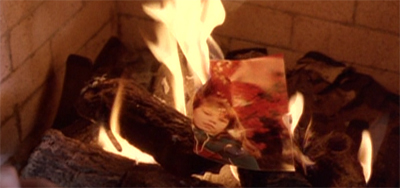
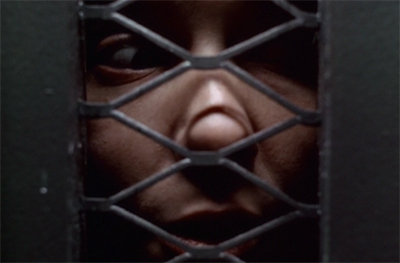
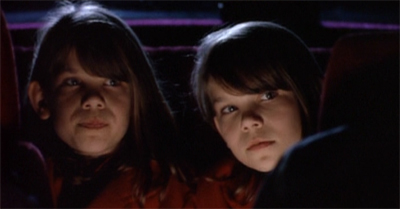



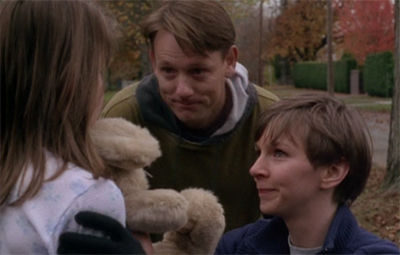

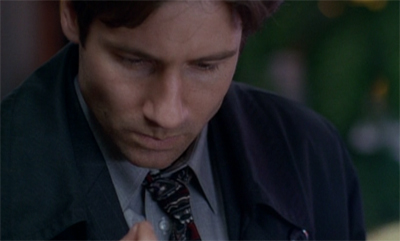


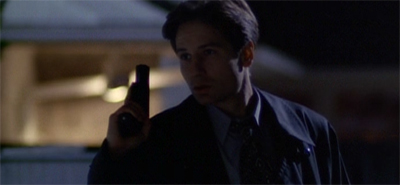
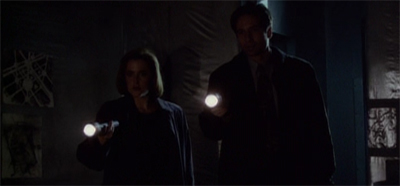

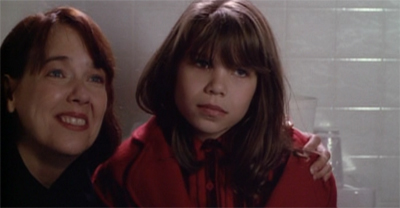





I love this episode partly for reasons that you seem to dislike – the fact that at times the audience is ahead of the agents, and at times behind other characters’ knowledge. I consider it one of the more skilful scripts of the series.
To me, Mulder and Scully’s failure to recognise more quickly that they are in danger is rooted in them thinking they’ve already solved the case. They’ve let down their guard because they are no longer ‘working’. I actually quite enjoy it when the show has them solve a puzzle wrongly, as it doesn’t happen often (and it’s very rare for them to not correct the error – it happens in ‘The List’ but that’s the only example I can immediately recall).
Fair point.
Still, it always seemed a little clunky to me.
This is a good thought piece on a very creepy ep that had always been a delightfully unsettling one for me. I think it is significant to note that Cindy and Teena are not directly products of government experimentation – rather they are unintended consequences, as it is the rogue actions of Eve 7/Sally Kendrick that created them. The government was not breeding these persons and seeding them with unwitting suburban families- it was the escaped product of their ‘controlled experiment’, (which they tried to lock away) that did that. Obviously that doesn’t absolve the government agency behind the Litchfield Experiment but it does lend a different spin to the cautionary message.
As I didn’t feel M and S were played as being unaware of the poisoning – quite the opposite, M figures it out quickly and warns Scully. It always struck me that they were obviously pretending to drink and being so overt and broad about their remarks about the ‘sweetness’ etc. in an attempt to fool the girls that their plan had succeeded.
I just recently discovered this site and have gone down the rabbit hole on the Star Trek TOS reviews, lots of great insights there and look forward to more time spent in these X-Files thoughts. Thank you!
Thanks, I’m glad you enjoyed the reviews!